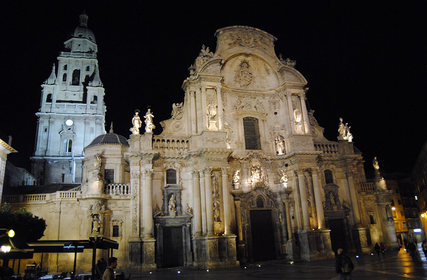Murcia is a city in south-eastern Spain, the capital and most populous city of the Autonomous Community of the Region of Murcia, and the seventh largest city in the country.
The Cathedral of Murcia was built between 1394 and 1465 in the Castilian Gothic style. Its tower was completed in 1792 and shows a blend of architectural styles. The first two stories were built in the Renaissance style (1521–1546), while the third isBaroque. The bell pavilion exhibits both Rococo and Neoclassical influences. The main façade (1736–1754) is considered a masterpiece of the Spanish Baroque style.
Other noteworthy buildings in the square shared by the Cathedral (Plaza Cardinal Belluga) are the colorful Bishop's Palace(18th century) and a controversial extension to the town hall by Rafael Moneo (built in 1999).
The Glorieta, which lies on the banks of the Segura River, has traditionally been the center of the town. It is a pleasant, landscaped city square that was constructed during the 18th century. The ayuntamiento (city hall) of Murcia is located in this square.
Pedestrian areas cover most of the old town of the city, which is centered around Platería and Trapería Streets. Trapería goes from the Cathedral to the Plaza de Santo Domingo, formerly a bustling market square. Located in Trapería is the Casino, a social club erected in 1847, with a sumptuous interior that includes a Moorish-style patio inspired by the royal chambers of theAlhambra near Granada. The name Plateria refers to plata (silver), as this street was the historical focus for the commerce of rare metals by Murcia's Jewish community. The other street, Traperia, refers to trapos, or cloths, as this was once the focus for the Jewish community's garment trade.
* Information from Wikipedia.org










